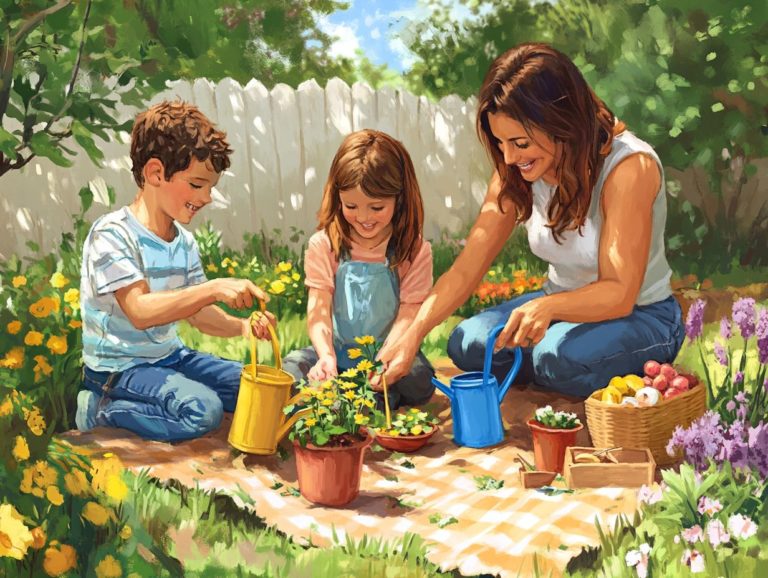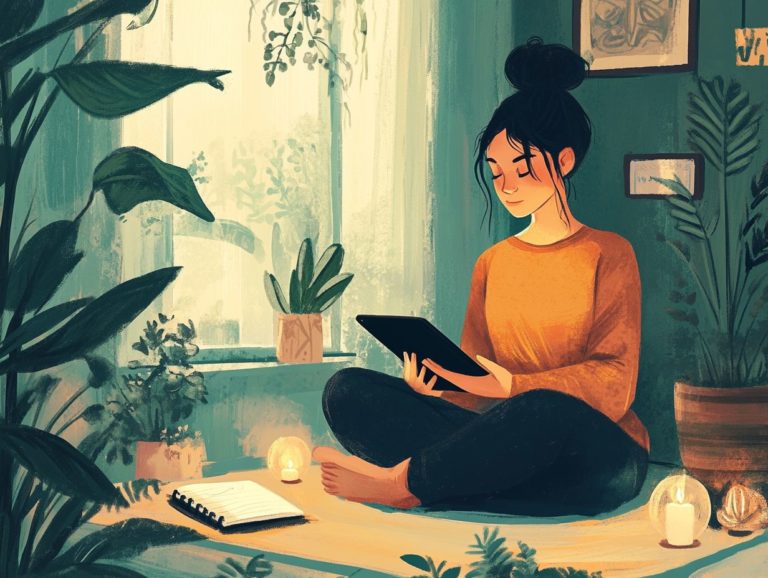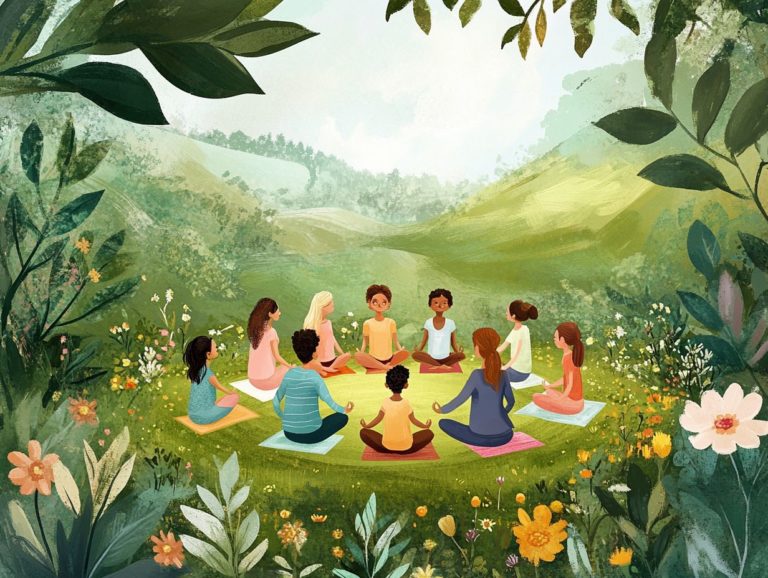Using Puppets for Mindfulness Conversations
In today s fast-paced world, it s essential for you to teach children the art of mindfulness. This article delves into the concept of mindfulness and its significance for young minds. It showcases how puppets can serve as a captivating tool in this endeavor.
By incorporating puppets into mindfulness discussions, you can create a fun and interactive environment. Here, children can learn vital techniques, enhance their emotional awareness, and improve their social skills.
Explore with us as you uncover practical strategies and the numerous benefits of using puppets for meaningful mindfulness conversations.
Contents
- Key Takeaways:
- What Is Mindfulness?
- Why Is Mindfulness Important for Children?
- What Are Puppets?
- How to Use Puppets for Mindfulness Conversations?
- Mindfulness Practices for Children
- What Are the Benefits of Using Puppets for Mindfulness Conversations?
- What Are Some Tips for Using Puppets for Mindfulness Conversations?
- 1. Choose Puppets that Resonate with Children
- 2. Use Simple and Clear Language
- 3. Create a Safe and Supportive Environment
- 4. Allow Children to Lead the Conversations
- Frequently Asked Questions
- What is the purpose of using puppets for mindfulness conversations?
- How can puppets be incorporated into mindfulness conversations?
- What are the benefits of using puppets for mindfulness conversations?
- What age group is suitable for using puppets in mindfulness conversations?
- Do I need special training to use puppets for mindfulness conversations?
- Are There Drawbacks to Using Puppets for Mindfulness Conversations?
Key Takeaways:

- Mindfulness can be introduced through the use of puppets, making the practice fun and engaging for children.
- Puppets can help children understand and practice mindfulness techniques, promoting social and emotional learning.
- Creating a safe and supportive environment allows children to lead conversations, enhancing the effectiveness of using puppets for mindfulness.
What Is Mindfulness?
Mindfulness is the art of being present and engaged in the moment. This practice significantly enhances the emotional well-being of children. By fostering the ability to manage feelings, it enables young learners to navigate their emotions with greater ease.
When you integrate mindfulness into early childhood education, you cultivate a nurturing classroom environment. This promotes social-emotional learning and creates a supportive community where children can thrive.
Why Is Mindfulness Important for Children?
Mindfulness holds significant importance for children, as it nurtures their emotional well-being. It sharpens their communication skills, leading to more constructive interactions in the classroom.
By incorporating mindfulness practices, educators equip children with the tools to manage their emotions. This enhances their capacity to engage meaningfully with peers and academic pursuits.
This essential skill lays the groundwork for their overall development and enriches their learning journey during the early years of education.
What Are Puppets?
Puppets serve as exceptional educational tools, embodying a myriad of characters and dynamics that elevate engagement and interaction within the classroom.
Through the art of puppetry, you can guide children in exploring emotions, storytelling, and social interactions in an enjoyable and imaginative manner.
By integrating distinct puppet voices and expressive movements, you have the opportunity to craft dynamic, interactive experiences. These not only captivate young learners but also deepen their understanding of complex concepts.
How Can Puppets Be Used for Mindfulness Conversations?
Puppets can serve as powerful tools in mindfulness conversations. They help guide children in expressing their feelings and navigating their emotions. Through puppet dialogue, you can model mindfulness practices, allowing students to connect with their emotional health playfully.
This method enriches their emotional vocabulary and makes mindfulness relatable for young learners. By using puppets as facilitators in discussions, you create a safe space where children feel at ease sharing their thoughts and feelings.
This imaginative approach bridges the gap between complex emotions and a child s understanding. It enables them to explore various scenarios as they interact with the puppets.
For example, a puppet can demonstrate how to take deep breaths when anxiety strikes or illustrate the importance of kindness while resolving conflicts. Puppet-based learning emphasizes collaboration, encouraging children to work together in identifying and addressing their emotions. This ultimately fosters a sense of community and enhances their emotional intelligence.
How to Use Puppets for Mindfulness Conversations?
Utilizing puppets for mindfulness conversations presents engaging strategies that invite children to participate. These strategies help them comprehend more effectively. By incorporating puppet activities like role play, you can cultivate a dynamic learning atmosphere.
In this environment, young learners feel secure in expressing their thoughts and emotions. This method enhances their engagement with mindfulness practices and nurtures their social-emotional development.
Mindfulness Practices for Children
1. Introduce the Concept of Mindfulness
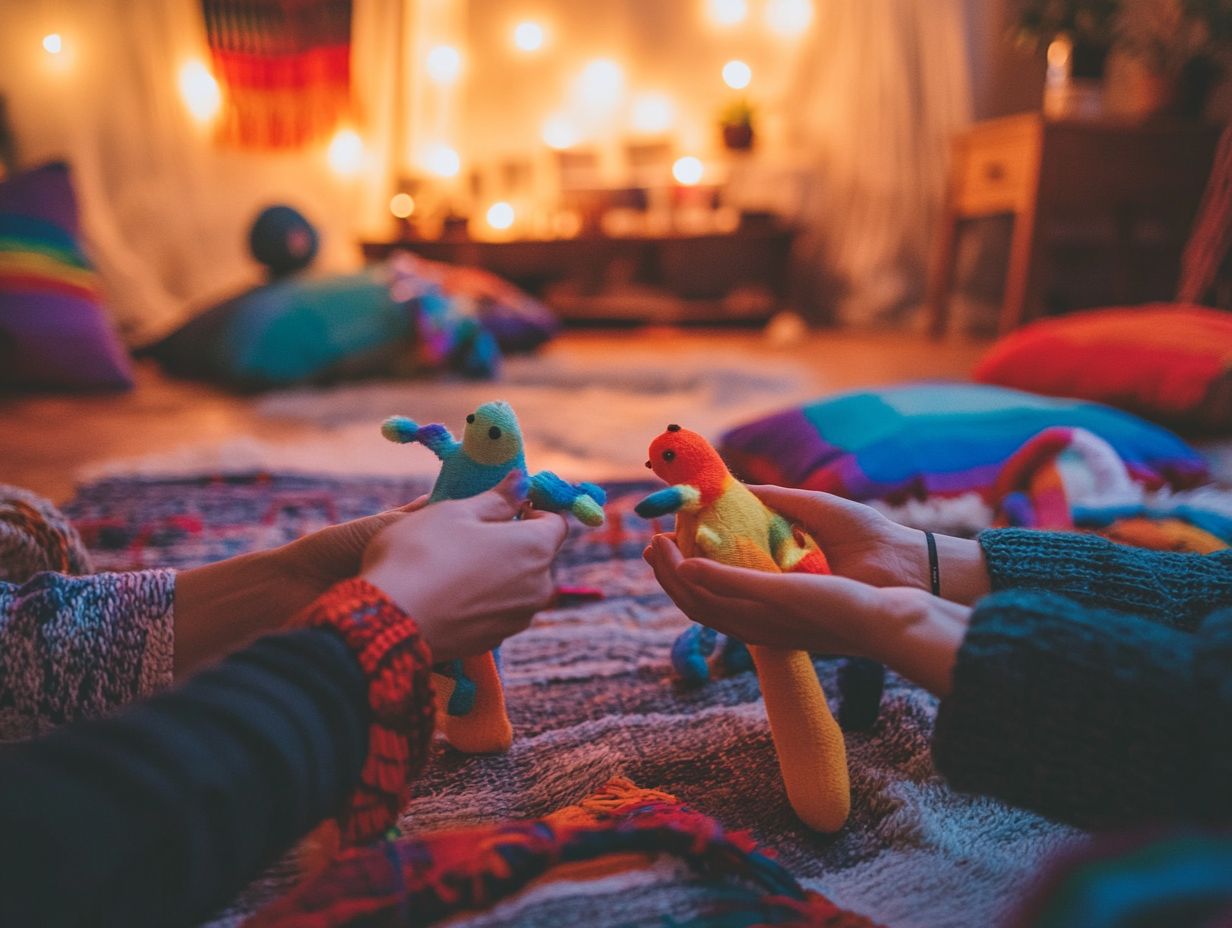
Introducing the concept of mindfulness to children means helping them appreciate its significance for self-regulation (the ability to manage emotions and behavior) and emotional well-being within their classroom community.
By using simple, relatable language and examples, you can guide them in understanding how mindfulness practices like being present and recognizing their feelings can enrich their interactions and learning experiences.
Incorporating engaging methods, such as storytelling, can vividly illustrate the concept, allowing children to connect emotionally with the characters and situations. Puppet demonstrations can serve as another effective tool, offering a playful yet impactful means of expressing feelings and exploring mindfulness techniques.
Facilitating guided discussions creates an open dialogue where children feel comfortable sharing their thoughts and experiences, making mindfulness practices feel more approachable.
By nurturing these skills, children not only enhance their emotional health but also lay a strong foundation for self-regulation, equipping them to navigate life’s challenges with resilience and empathy.
2. Use Puppets to Demonstrate Mindful Breathing
Using puppets to demonstrate mindful breathing offers an engaging approach to teaching children this essential mindfulness technique. You can animate the puppets to illustrate deep breathing exercises, showcasing their expressions of calmness and focus, encouraging the children to follow along and actively participate.
To seamlessly incorporate this practice into your classroom routines, consider introducing a designated ‘mindful moment’ during the day perhaps at the start or end of a lesson. Begin by selecting a puppet that embodies a sense of peacefulness; this character will guide your class through the breathing exercises.
Each student can imitate the puppet s movements and breathing patterns, fostering a sense of belonging and community in the activity.
To boost creativity, invite your students to create their own puppets, allowing them to visually express their understanding of mindfulness. The interactive nature of puppetry not only captivates attention but also transforms the practice of mindful breathing into a delightful and memorable experience.
3. Role Play with Puppets to Practice Mindful Communication
Engaging in role play with puppets offers an exceptional avenue for practicing mindful communication among children. By weaving puppet interactions into the curriculum, you can craft scenarios that enable your students to express their feelings and hone their active listening skills.
These interactive experiences are invaluable in helping young learners navigate complex emotions and cultivate empathy for others. Imagine designing scenarios where puppets encounter common social situations, like resolving a disagreement or lending support to a friend in need.
In these moments, children can keenly observe and model the appropriate responses demonstrated by the puppets.
It s beneficial to encourage open discussions following each role-play exercise. This reinforces the lessons learned and fosters a supportive atmosphere for guidance.
By establishing a safe space where children feel free to express themselves, you enhance the likelihood that they will embrace and internalize these essential communication techniques.
4. Encourage Children to Create Their Own Mindfulness Puppet Shows
Encouraging children to create their own mindfulness puppet shows allows them to express their creativity while reinforcing their understanding of mindfulness concepts. As they dive into puppet-making activities, they can design characters that embody various emotions and scenarios, making the learning process not only enjoyable but also profoundly impactful.
This exciting process ignites their imagination and fosters collaboration among peers, as they work together to craft stories that reflect shared experiences and feelings.
You can guide them by introducing themes like gratitude, empathy, or managing anxiety, sparking discussions that deepen their comprehension of these vital concepts.
By utilizing simple materials such as socks, paper, or felt, children engage their motor skills while breathing life into their imaginative ideas. This hands-on approach nurtures a sense of ownership and pride in their creations, ultimately enhancing their emotional intelligence and creativity within an educational setting.
Don’t miss the chance to let your students explore their creativity through puppet shows!
What Are the Benefits of Using Puppets for Mindfulness Conversations?
Using puppets for mindfulness conversations offers numerous benefits that significantly enhance emotional well-being and foster a supportive classroom atmosphere. These engaging tools capture students’ attention, making mindfulness practices more relatable and encouraging their participation in social-emotional learning activities.
This approach helps educators create a nurturing classroom community where every child feels comfortable sharing their emotions.
1. Makes Mindfulness Fun and Engaging for Children
Puppets make mindfulness fun and exciting for both you and your children, turning abstract concepts into relatable moments. By using puppet characters, you can capture your students’ imaginations, making the learning process enjoyable and interactive. This playful approach grabs attention and reinforces the importance of mindfulness in their everyday lives.
For example, imagine a puppet named Calming Cat guiding your students through deep breathing exercises, while Mindful Monkey encourages them to observe their thoughts and feelings without judgment. These characters offer a valuable platform for discussion and serve as comforting figures that help alleviate anxiety.
With every puppet interaction, children learn to articulate their emotions, fostering a sense of safety and belonging in the classroom. By embodying mindfulness through puppetry, you can create memorable experiences that resonate long after the lesson ends.
2. Helps Children Understand and Practice Mindfulness Techniques
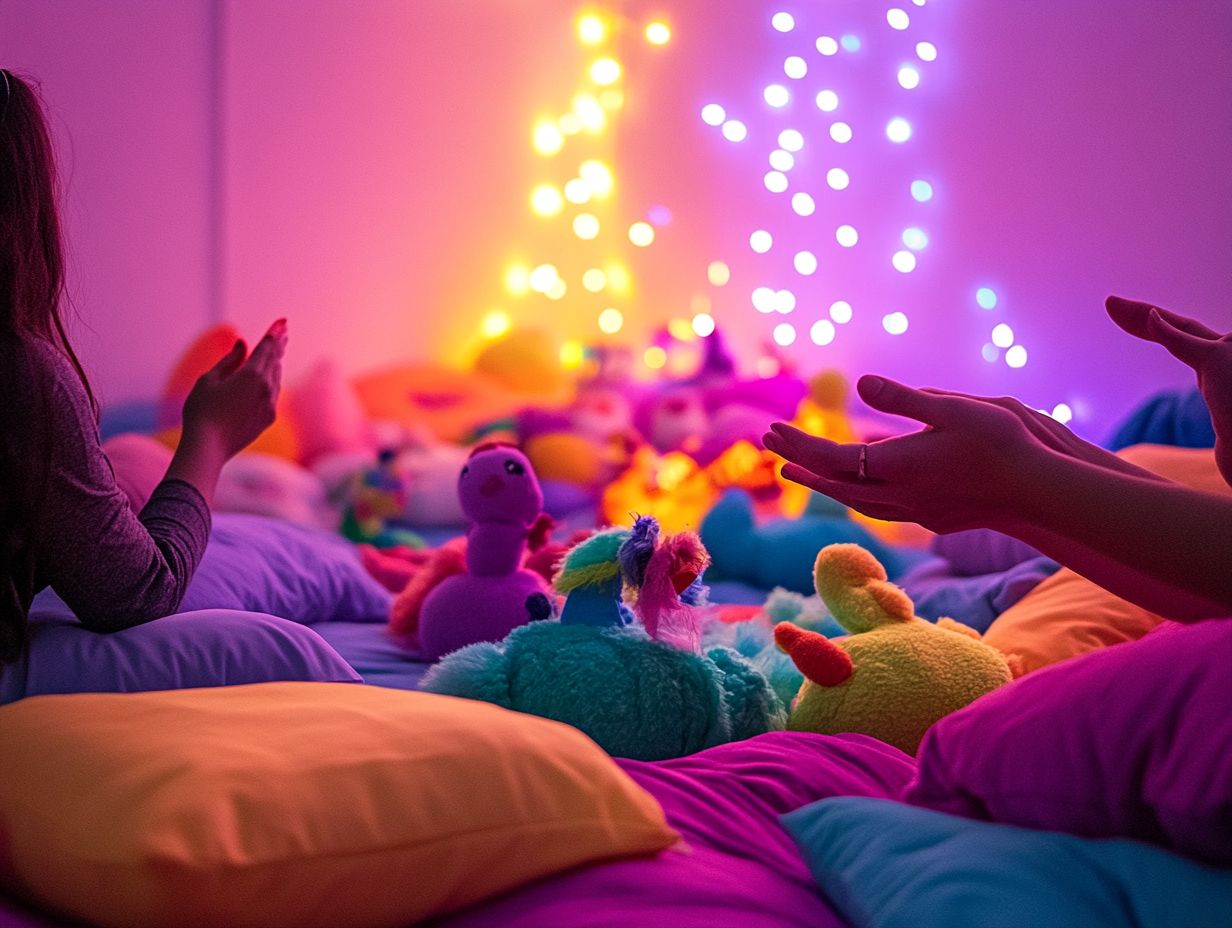
Incorporating puppets into the classroom enhances your ability to teach children effective mindfulness techniques. By utilizing puppet modeling, you can demonstrate various mindfulness exercises, allowing children to visualize and experience these techniques in a safe, playful environment that supports their emotional health.
This engaging visual approach not only captures their interest but also fosters a deeper connection to the concepts you’re teaching. When a puppet practices deep breathing or guided visualization, children more readily grasp these otherwise abstract ideas through observation and imitation. As they mimic the puppet’s actions, they deepen their understanding and are encouraged to integrate mindfulness into their daily routines.
The playful nature of puppetry also lowers the intimidation factor often associated with mindfulness practices, making it easier for children to share their feelings and enhance their overall emotional well-being.
3. Encourages Creativity and Imagination
Using puppets in mindfulness conversations opens a world of creativity and imagination for you and the children in your care. Through puppet-making activities, students can express themselves artistically while exploring their emotions, enriching their overall learning experience.
Engaging with puppets allows children to unlock their imaginative potential while learning to articulate their feelings in a safe and supportive environment. This imaginative play acts as a powerful tool in educational settings, where art and creativity are integrated into the curriculum. Such integration fosters a sense of community and belonging among students, helping them navigate their emotions and cultivate empathy.
As they embark on puppet-led storytelling or role-play, children refine their communication skills and gain valuable insights into their own feelings and those of others. This contributes to a holistic approach to personal growth and academic success, creating a rich tapestry of learning and emotional development.
Conclusion
In summary, using puppets for mindfulness conversations enriches emotional well-being, fosters creativity, and helps children understand and practice mindfulness techniques. These playful interactions not only enhance learning but also nurture a supportive classroom environment.
Try incorporating puppets in your next mindfulness session and share your experiences!
4. Promotes Social and Emotional Learning
Puppets hold a remarkable potential for enhancing social and emotional learning in your classroom. By facilitating interactions with puppets, you create meaningful opportunities for children to explore their feelings, cultivate empathy, and forge stronger relationships within their classroom community.
Imagine using a puppet to tell a story about feeling left out during playtime. This prompts your students to share their own experiences and emotions related to exclusion. Such interactions not only validate their feelings but also encourage them to express empathy toward one another.
In another scenario, a puppet could illustrate the act of sharing toys, sparking discussions about friendship and cooperative behavior. These activities are not merely playful; they impart essential social skills while fostering a safe space for emotional expression.
In this environment, children learn from both the puppets’ actions and each other’s responses, enriching their social landscape.
What Are Some Tips for Using Puppets for Mindfulness Conversations?
To effectively leverage puppets for mindfulness conversations, it s essential to employ thoughtful strategies that enhance their impact on children’s learning and engagement.
By setting clear classroom rules and guidelines for puppet usage, you can cultivate a structured environment where children feel enabled to express themselves and delve into mindfulness concepts through the interactive medium of puppetry.
1. Choose Puppets that Resonate with Children
Choosing puppets that resonate with children is essential for engaging in meaningful mindfulness conversations. The right puppet characters can evoke emotions and encourage children to connect with the material, creating an atmosphere of comfort and openness when discussing emotional well-being.
When selecting the right puppets, it’s vital to consider character traits that align with the themes of your conversation. For example, puppets that embody kindness, curiosity, or bravery can serve as excellent lead characters in discussions about emotions or interpersonal relationships. A cheerful puppet like a friendly dragon could inspire children to express their feelings of happiness or excitement, while a thoughtful rabbit might facilitate discussions around anxiety or fear.
Moreover, puppet designs that reflect diversity can enhance emotional relevance, allowing children from various backgrounds to see themselves in the stories being told. This approach promotes inclusivity and understanding. Ultimately, these considerations contribute to creating meaningful interactions that nurture emotional growth.
2. Use Simple and Clear Language
Using simple and clear language is crucial when you’re facilitating mindfulness conversations with puppets. This ensures that children grasp the concepts being presented. This approach not only enhances communication skills but also makes it easier for young learners to engage with the material and share their thoughts.
By incorporating straightforward vocabulary and relatable scenarios, puppets transform into effective tools for teaching mindfulness. For example, imagine a puppet saying, “When I feel upset, I take three big breaths to calm down.” This allows children to connect with the emotions being addressed.
Puppets can also model active listening by asking questions like, “What makes you happy?” This encourages children to reflect on their own feelings. Such direct interactions not only deepen connections but also create a safe space where young learners feel enabled to share their experiences and emotions.
3. Create a Safe and Supportive Environment
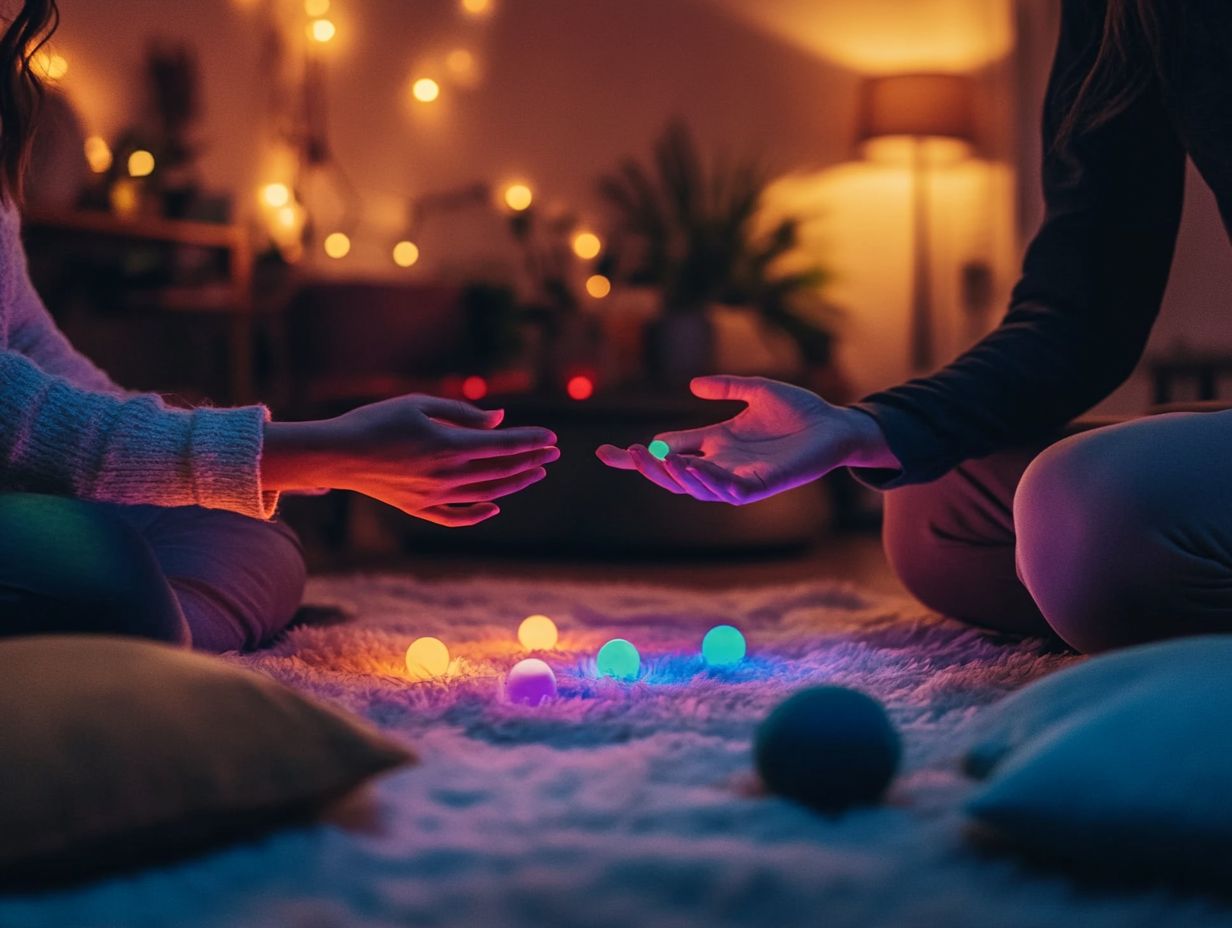
Creating a safe and supportive environment is essential for fostering successful mindfulness conversations with puppets. This enables children to share their emotions and experiences without hesitation. By building a nurturing classroom community, you allow students to explore their feelings free from the fear of judgment, which promotes their emotional well-being and strength.
To achieve this, you can implement strategies like establishing clear ground rules, encouraging active listening, and modeling vulnerability in your emotional expressions. Engaging in collaborative group activities where mindfulness practices become a shared experience will deepen the connections among students.
By consistently reinforcing respect and empathy, your classroom can transform into a sanctuary. In this space, every child s voice is truly valued.
Incorporating cooperative games or circle time discussions that center around puppet interactions can significantly enhance trust and emotional safety. This paves the way for deeper connections and healthier expression of feelings. This supportive atmosphere creates a vibrant, caring community that thrives on empathy!
4. Allow Children to Lead the Conversations
Allowing children to take the lead in conversations with puppets fosters a deeper emotional understanding. It also instills a sense of ownership over their learning journey. This approach enables them to express their thoughts and feelings without restraint, enhancing engagement and forging stronger connections to mindfulness concepts.
By encouraging students to take charge during puppet activities, you create a safe and dynamic environment where they feel valued and genuinely heard. Techniques such as open-ended questions can serve as gentle prompts, inviting children to reflect on their emotions and share their unique perspectives.
For example, you might ask, “How do you think the puppet feels right now?” or “What would happen if the puppet faced a challenge?” Such inquiries promote critical thinking and bolster their conversational skills. Incorporating role-playing scenarios allows each child to step into the puppet’s shoes, cultivating empathy and strengthening peer connections as they collaborate and share their insights.
Frequently Asked Questions
What is the purpose of using puppets for mindfulness conversations?
The purpose of using puppets for mindfulness conversations is to create a safe and non-threatening space for children to express their thoughts and emotions. Puppets can help children feel more comfortable and open up about their feelings, which is an important aspect of mindfulness.
How can puppets be incorporated into mindfulness conversations?
Puppets can be used as a tool to introduce mindfulness concepts to children, such as deep breathing and body awareness. They can also act as a medium for children to express their thoughts and emotions through role-playing and storytelling.
What are the benefits of using puppets for mindfulness conversations?
Using puppets for mindfulness conversations can help children develop self-awareness, emotional regulation, and empathy. It can also improve their communication and problem-solving skills and foster a positive attitude towards mindfulness practices.
What age group is suitable for using puppets in mindfulness conversations?
Puppets can be used for mindfulness conversations with children of various ages, but they are most commonly used with preschool and elementary-aged children. However, older children and even adults can also benefit from the use of puppets in mindfulness activities.
Do I need special training to use puppets for mindfulness conversations?
No, you do not need special training to use puppets for mindfulness conversations. However, it can be helpful to familiarize yourself with basic mindfulness techniques and understand child development to effectively incorporate puppets into your conversations.
Are There Drawbacks to Using Puppets for Mindfulness Conversations?
Using puppets for mindfulness conversations is beneficial. However, they should not replace professional therapy.
Puppets can help promote mindfulness and spark conversations. If a child faces deeper issues, getting professional help is key!


